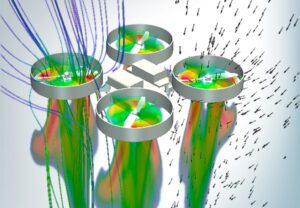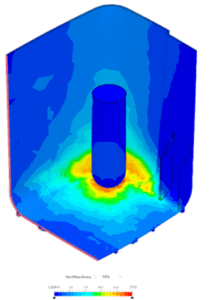
UNSPACE focuses on the integration of engineering and strategy and solves unique engineering challenges with consultative research, analysis, and cutting-edge technologies. Their team of engineers and business professionals optimizes project success by ensuring ideas are engineered to their maximum potential.
UNSPACE is an engineering and technology consultancy working on research and commercial projects. Their capabilities include rapid prototyping, CAD/CAM design, feasibility research, mechatronic design, product integration, engineering simulation, and more. They have been using SimScale for FEA and thermal analysis on projects and have now expanded into flow simulation using CFD. Integrating simulation at the early design stage is vital to their strategy, especially on R&D projects.
A recent project, for example, was the design and optimization of a 3D-printed pressurized canister where SimScale was employed for stress analyses to optimize the wall thickness and internal shape of the canisters. High-pressure vessels have stringent safety standards that must be adhered to during the lifecycle of the product in use. The original design (left) exhibited unsafe stresses on the walls and was improved with a new design (right) that reduced the same stress level by a factor of 4. UNSPACE also works on blue-sky research projects such as the grant-funded proof-of-concept study of a novel gravitational detector.


UNSPACE was tasked with designing and building a research system capable of measuring local changes to the gravitational field. Such a task was considered complex due to the inherent physical challenge of creating an instrument sensitive enough to isolate local field measurements from Earth’s overpowering gravitational field. The device would need subsystems, including lasers, high-speed motors, control systems, mechanical oscillators, vibration dampeners, and accelerometers.

To complicate matters, feasibility models indicated that a specific subsystem would need to operate at 50,000 to 100,000 RPMs and add extreme vibration to the project, which necessitated advanced simulation software capable of modeling these severe environmental challenges.
During the design and pre-build phase of the project, a collaboration of UNSPACE engineers, third-party engineers, and scientific researchers evaluated Finite Element Analysis (FEA) products and determined that SimScale could meet their structural, fluid, and thermal simulation requirements. After completing an exhaustive 3D model of the gravitational detector (EGAD), the CAD geometries were imported into SimScale. SimScale supported UNSPACE in defining the boundary conditions, setting up mechanical contact points, and creating a bespoke materials library for the project. With the initial setup complete, the team was able to utilize the parallel simulation capabilities in SimScale to evaluate multiple design scenarios under various environmental conditions.
The simulation output was vital in helping the team finalize a heat sink design that could dissipate extreme heat and a structural framework capable of supporting the torque and vibrations associated with a 100,000 RPM subsystem. Engineers with previous experience using legacy desktop CFD software were pleased to learn that the effort to set up models and run simulations in SimScale was significantly less than anticipated. Using SimScale simulations to inform their designs, they cut the quantity and weight of fabricated parts and the time to begin experiments by nearly 50%. At the time of writing, the simulation results were critical to demonstrating the potential of this device, and UNSPACE has been awarded a fully funded second phase of the project.

Research is expensive and carries great inherent risk in unproven technology. We use SimScale to help us quantify the design performance of our complex ideas and to reduce the risk when moving to the prototyping stage. SimScale has been a breeze to learn. The support team is amazing with setting up sessions to help teach different best practices. The learning center is robust, with detailed descriptions of the available functions. Lastly, the tutorials are a great asset for setting up all the different simulations. We are now looking to apply some advanced features in SimScale, including vibration and harmonic analysis and the newly released electromagnetics simulation.

Phillip Lentz
CEO and Founder of UNSPACE





Sign up for SimScale
and start simulating now